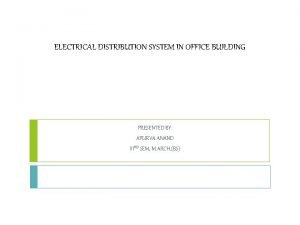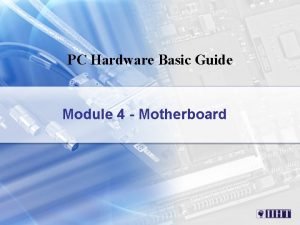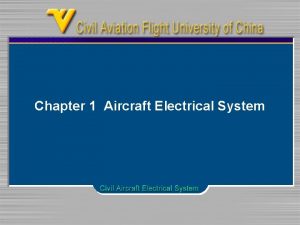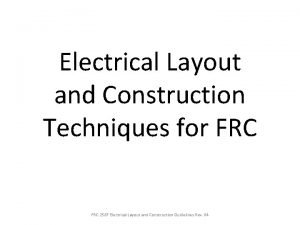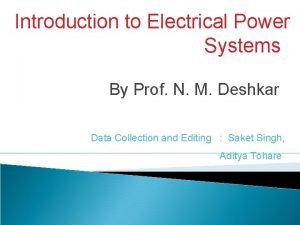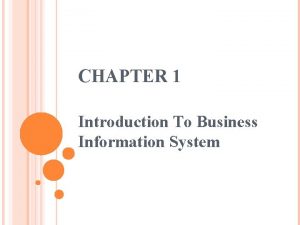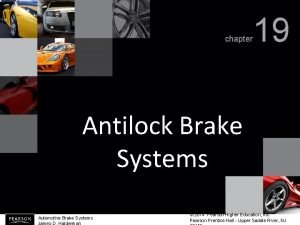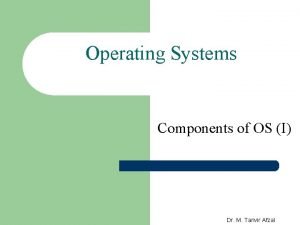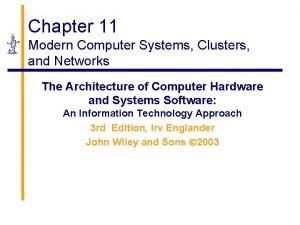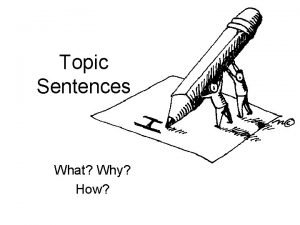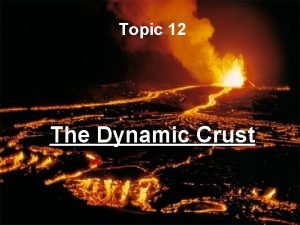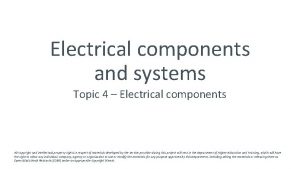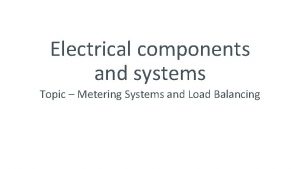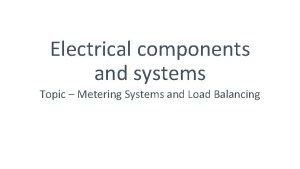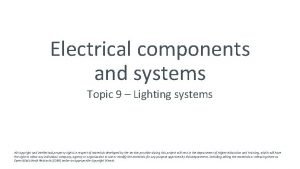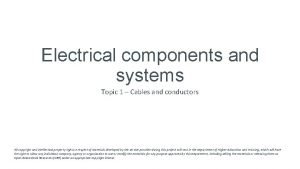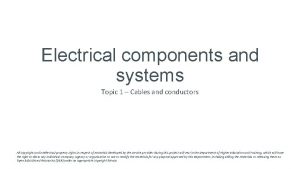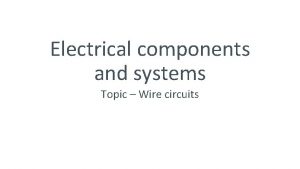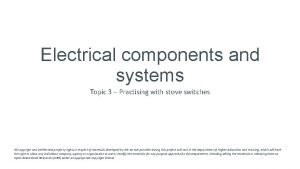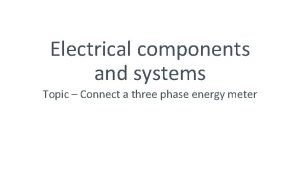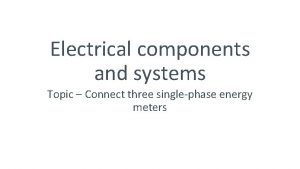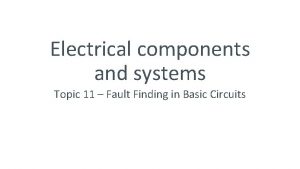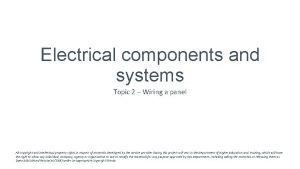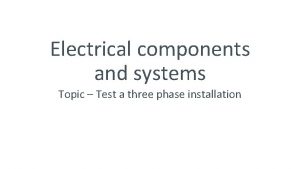Electrical components and systems Topic 2 Electrical components













































- Slides: 45

Electrical components and systems Topic 2 – Electrical components All copyright and intellectual property rights in respect of materials developed by the service provider during this project will vest in the Department of Higher Education and Training, which will have the right to allow any individual, company, agency or organisation to use or modify the materials for any purpose approved by this Department, including selling the materials or releasing them as Open Educational Resources (OER) under an appropriate copyright license.

Circuit protection Unit 4. 2

Assumed prior learning Contactors and overload relays • Don’t feel confident yet about these topics? Click on each to review the content. • Feeling confident? Click next to proceed with this unit.

Outcomes • Explain the functions and operations of the different types of fuses. • Identify and explain the operation of the two types of circuit breakers.

Introduction Contactors, overload relays, fuses and circuit breakers are the main components in an electrical circuit. While overload relays protect the motor, circuit breakers and fuses protect the circuit. In this lesson we find out more about the circuit protection provided by fuses and circuit breakers. CONTACTORS, OVERLOADS, FUSES AND CIRCUIT BREAKERS

What are fuses used for? A fuse is a device for protecting a circuit or appliance from excessive current flowing across it (short circuit current in defective circuits or overload currents in circuits that are not defective). CONTACTORS, OVERLOADS, FUSES AND CIRCUIT BREAKERS

How do fuses work? A fuse protects the circuit by disconnecting the circuit from the supply when the fuse element melts. The fuse element or fuse wire in a fuse is designed to melt when the current through it exceeds a certain value for a certain time. Note: the fuse element is connected in series with the electrical supply to the appliance, so that when the fuse blows (opens) it will open the entire circuit and stop current through the components.

Experimenting with fuses Watch the video to see a simple demonstration on how a low rating electrical fuse works. Vid 01: Experimenting with fuses

Materials used for fuse elements The materials commonly used as fuse elements are: • Copper – tends to oxidise; • Tin - leaves a vapour that could extend the duration of the arc; • Lead - which splashes and could damage adjacent circuits; • Zinc - affords time delay • Silver - used for high rupturing capacity (h. r. c. ) fuses

Fuse element materials The material used as a fuse element must have the following properties; low melting point, low ohmic resistance, high conductivity, low cost and it should be free from deterioration. There is no material that satisfies all of the above properties. METAL MELTING POINT IN C RESISTANCE in -mm SILVER 980 16 TIN 240 112 ZINC 419 60 LEAD 328 210 COPPER 1090 17 ALUMINIUM 665 28

Types of fuses The two types of fuses in general use are: • The semi-enclosed type; • Totally enclosed type or cartridge fuse (h. r. c. fuse) Vid 02: Construction and selection of fuses

After watching Video 02 on the construction and selection of fuses answer the questions that follow.

Question 1 Give the definition of a fuse. ENTER ANSWER HERE

Question 2 Name the two types of fuses in general use. 1) 2)

Question 3 Semi-enclosed fuses are normally used to protect circuits exceeding 30 A. TRUE Click on the correct answer. FALSE

Question 4 What type of fuse is shown below? A ENTER ANSWER HERE

Question 5 What is ‘A’ in this fuse diagram called? A ENTER ANSWER HERE

Function of a circuit breaker A circuit breaker is a mechanical switching device, used to protect electrical circuits and equipment in the event of fault current and over-current. CONTACTORS, OVERLOADS, FUSES AND CIRCUIT BREAKERS

Difference between circuit breaker and fuse A fuse is a piece of metal that melts when overheated due to an excessive flow of current whereas a circuit breaker has a switching mechanism, which is activated due to power overloads and short circuits. Fuses are faster to disrupt the current flow but they must be replaced after a piece of metal melts down while circuit breakers can be reset and used again.

Advantages of circuit breakers A circuit breaker can: • be used as an isolator, • simply be reset after a fault or over-current (it does not have to be replaced), and • be used in case of overload and short-circuit conditions.

Types of breakers There are two basic types in use: • The magnetic type, • The thermo-magnetic type. Vid 03: Types of circuit breakers and arc quenching

Selection of circuit breakers The ratings of circuit breakers are clearly marked on them. Take care when installing or replacing circuit breakers that the correct rating in terms of amperage and time delays (where appropriate) are taken into account.

After watching Video 03 answer the following questions.

Question 1 List three advantages of circuit breakers over fuses. 1) 2) 3)

Question 2 What is the function of the plunger in a magnetic-type circuit breaker? a) b) c) d) Increase the strength of the magnetic flux. Damping or slowing down effect. Bend when it is heated. To quench the arcs.

Question 3 Name two types of circuit breakers. 1) 2)

Question 4 Arc quenching is achieved in mini circuit breakers by a number of metal plates placed diagonally and below the contacts as arc interrupters. TRUE Click on the correct answer. FALSE

Question 4 A circuit breaker may be used as a disconnector provided it complies with the standards of the relevant disconnectors. TRUE Click on the correct answer. FALSE

Question 4 An abnormally low ambient temperature will delay the tripping of thermal magnetic circuit breakers on overload. TRUE Click on the correct answer. FALSE

Let’s review: In this lesson we have covered: üFunction and operation of fuses üTypes of fuses üFunction and operation of circuit breakers üTypes of circuit breakers Make sure you have a complete understanding of all the work covered here before you start the next unit.

Video brief - Vid 02 Expert technician explaining the construction of fuses Voice over Three types of fuse are used as circuit protection ; the rewireable or semi-enclosed fuse, enclosed fuses and the high rupturing capacity (HRC) fuse. We will discuss each one. For the applicable standards of fuses and fuse holders see Table 4. 1 of the SANS Code. In older homes the switchboard may still have semienclosed rewireable fuses. These fuses are ceramic plug-in units on the switchboard. They have a length of fuse wire connected between two screws on the contacts of a fuse holder and operate in an overload or short-circuit. The semi-enclosed fuse is made up of a fuse holder, an element and a fuse carrier. The holder and carrier can be made of porcelain or bakelite. Image

Video brief - Vid 02 Expert technician explaining the construction of fuses Voice over The figure shows the construction of a semi-enclosed, rewireable fuse. • The fuse holder must never be wired with an element exceeding the rated value of the fuse, since it will then fail to protect the appliance or circuit for which it was intended. • The element is screwed to a contact at each end and wired through an asbestos, ceramic, or porcelain tube, which serves to enclose the spark when the fuse blows. See SANS Regulation 6. 10 for the use of fuses not being permitted as overcurrent protection in residential installations. Image

Video brief - Vid 02 Expert technician explaining the construction of fuses Voice over The relative advantages of semi-enclosed fuses is that they are; cheap and easy to rewire. The relative disadvantages are : • It deteriorates easily because it is not enclosed; • Ratings are unreliable; • Gives no indication if blown; • Not effective under short-circuit conditions; • Can be wrongly rewired with an element of incorrect value, thus negatively affecting the rating of the fuse. Please note that: Semi-enclosed fuses are normally not used to protect circuits exceeding 30 A. Image

Video brief - Vid 02 Expert technician explaining the construction of fuses Voice over An enclosed fuse is one in which the element is totally enclosed by means of a container or sealed tube, thus protecting the element from the atmosphere and containing the spark when it blows. We will discuss a few important examples of enclosed fuses. , the cartridge fuse, Edison screw fuse and High rupturing capacity (h. r. c. ) fuses. Image

Video brief - Vid 02 Expert technician explaining the construction of fuses Voice over This is a Cartridge fuse. The fuse element is enclosed by means of a glass, porcelain or ceramic tube. The ends of the elements are soldered to tinned brass caps. They are commonly used in motor vehicles. Image

Video brief - Vid 02 Expert technician explaining the construction of fuses Voice over The Edison screw fuse is another form of cartridge fuse, since its element is enclosed in a glass container. It is commonly found in stoves. Image

Video brief - Vid 02 Expert technician explaining the construction of fuses Voice over High rupturing capacity or h. r. c fuses are cartridge fuses able to interrupt high currents. • Their elements are manufactured from silver; • Apart from the fuse element, it also has an indicating element, which is wired in parallel with the fuse element and has the function to indicate if the fuse is blown. A small quantity of explosive powder is placed in a tiny hole behind the indicating label. If the indicating element melts when the fuse blows, the powder ignites and blows a hole in the indicating label. • The fuse element is surrounded by an insulating material such as fire clay or silica granules, which quench the arc instantaneously. • An important characteristic is that it can operate at very high and very low over-currents, with different time delays. The higher the current, the shorter the time delay Image

Video brief - Vid 02 Expert technician explaining the construction of fuses Voice over Lastly we look at ; Quick blow and slow blow fuses. Normal fast-blow fuses are the most general purpose fuses. A time-delay fuse (also known as an anti-surge or slow-blow fuse) is designed to allow a current which is above the rated value of the fuse to flow for a short period of time without the fuse blowing. Fuses are designed to be capable of carrying current at 50% above the rated value for approximately four hours, but small overloads for an indefinite period. Slow blow fuses are for example, incorporated in the starting circuits of motors where the overload during starting will exceed 50%. The fuse must be able to carry this current for a few seconds without blowing. Fuse elements are made of zinc. Image

Video brief - Vid 02 Expert technician explaining the construction of fuses Voice over A quick blow fuse is designed to blow within a very short period of time during overload. This type of fuse is used in circuits that are very sensitive to overload currents. Be careful in your selection of fuses. Fuses are normally clearly marked. Take care to replace fuses with ones of correct rating, considering both amperage and time delay where applicable. When rewiring semi-enclosed fuses, take care to rewire them with element wire of the correct (same) value. Image

Video brief - Vid 03 Expert technician explaining the different types of breakers in use Voice over Breakers can be a small device to guard one household appliance or big switchgear designed to shield high voltage circuits that supply a complete city. Circuit breakers can be classified according to its features such as voltage class, construction type, interrupting type, and structural features. For the applicable standards of circuit breakers see Table 4. 1 of the SANS Code. A circuit-breaker that is used as a main or local switch disconnector SANS Regulation see 6. 9. 4 shall comply with the relevant requirements of a standard given in clause 4 for switch-disconnectors, or, alternatively, a switch-disconnectorshall be positioned on the supply side of the circuit-breaker. We will discuss the operating principle of a magnetic circuit breaker and a thermo-magnetic circuit breaker. Image

Video brief - Vid 03 Expert technician explaining the different types of breakers in use Voice over Magnetic circuit breakers use a solenoid (electromagnet) whose pulling force increases with the current. The operating principle of a magnetic circuit breaker (also called a mini circuit breaker or m. c. b. ) is to trip if the magnetic flux produced by the current exceeds a pre-set limit. Image

Video brief - Vid 03 Expert technician explaining the different types of breakers in use Voice over Let’s look at the construction of a magnetic-type circuit breaker. • A current coil is connected between the input and output terminals. It is wound around a non-magnetic cylinder, which contains a soft iron plunger in oil. • The function of the plunger is to increase the strength of the magnetic flux as it is pulled towards the centre of the coil. • The oil (in the damping pot) has a damping or slowing down effect that provides the time delay. • When the plunger reaches the centre of the coil, the flux is sufficient to attract the armature, which causes the breaker (m. c. b. ) to trip. • Under short circuit conditions the current may reach values of 2 500 A, which will set up a flux in the coil that is strong enough to attract the armature without Image

Video brief - Vid 03 Expert technician explaining the different types of breakers in use Voice over The difference between the magnetic and thermomagnetic circuit breaker is that thermo-magnetic has both thermal (for overload trip) and magnetic (for inrush/instantaneous trip) elements. This is used primarily for conductor protection. The magnetic only breaker is mainly used for motor protection. The majority of circuit breakers are thermo-magnetic, which means they accomplish electrical protection by combining two mechanisms that respond to heat and magnetic fields. Image

Video brief - Vid 03 Expert technician explaining the different types of breakers in use Voice over The construction of a thermo-magnetic (also called thermal-magnetic) circuit breaker is as follows: • A bimetal strip is incorporated between the input and output terminals. The bimetal strip will bend when it is heated and produce pressure on the tripping mechanism, causing the m. c. b. to trip. • The time delay is achieved by the time it takes for the current to heat up the bi-metal strip sufficiently to trip the m. c. b. • In the case of a short-circuit, the magnetic flux produced is sufficient to attract the tripping lever and trip the m. c. b. Image

Video brief - Vid 03 Expert technician explaining the different types of breakers in use Voice over Image When the current carrying contacts of the circuit breaker are moved apart, an arc is formed, which persists for a short period after the separation of contacts. This arc is dangerous due to the energy generated in it in the form of heat which may result in an explosive force. The circuit breaker should be able to extinguish the arc without causing disturbances to the equipment or danger to the operator. Demonstration by presenter similar to: https: //www. youtube. com/watch? v=q 7 bo. SVg. CRN 0 • • In mini circuit breakers it involves a number of metal plates placed diagonally and above the contacts as arc interrupters. They divide and absorb the spark, thus protecting the contact points. Experience has shown that in large circuit breakers, if the arc is broken in oil instead of in air,
 Clueing topic sentence
Clueing topic sentence Tapic about internet
Tapic about internet Topic 2 free enterprise and other economic systems
Topic 2 free enterprise and other economic systems Rising main electrical
Rising main electrical Module 4 topic 2 components of the space management system
Module 4 topic 2 components of the space management system Supporting sentences could be irrelevant to the topic.
Supporting sentences could be irrelevant to the topic. Module 10 topic 2 drivers ed
Module 10 topic 2 drivers ed Decision support systems and intelligent systems
Decision support systems and intelligent systems Aircraft electrical system components
Aircraft electrical system components Frc control system layout
Frc control system layout Mathematical modelling of mechanical systems
Mathematical modelling of mechanical systems Introduction to electrical power systems
Introduction to electrical power systems One electrical systems
One electrical systems Components of operating systems
Components of operating systems Components of operating systems
Components of operating systems Components of operating systems
Components of operating systems Components of information system
Components of information system What are the elements of media
What are the elements of media Kelsey-hayes abs module diagram
Kelsey-hayes abs module diagram Components of operating system
Components of operating system 5 components of is
5 components of is Computer systems components
Computer systems components Principles of complex systems for systems engineering
Principles of complex systems for systems engineering Embedded systems vs cyber physical systems
Embedded systems vs cyber physical systems Elegant systems
Elegant systems Basic tools in making simple electrical gadgets
Basic tools in making simple electrical gadgets Topic sentence structure
Topic sentence structure Topic 15 periods authors and genres
Topic 15 periods authors and genres Topic and closing sentences
Topic and closing sentences Difference between topic sentence and thesis statement
Difference between topic sentence and thesis statement Topic sentence in paragraph
Topic sentence in paragraph Percolation vs infiltration
Percolation vs infiltration Topic 7 economic performance and challenges
Topic 7 economic performance and challenges Expresin
Expresin Landscape development and environmental changes
Landscape development and environmental changes Topic 12 earth's dynamic crust and interior
Topic 12 earth's dynamic crust and interior Thesis transition
Thesis transition Amanda karim
Amanda karim What does central idea mean
What does central idea mean Romeo and juliet topic sentence
Romeo and juliet topic sentence Topic and objectives examples
Topic and objectives examples Is the main idea the theme
Is the main idea the theme Hook thesis statement
Hook thesis statement Happy monday answer key
Happy monday answer key A grandparent topic sentence
A grandparent topic sentence Difference between thesis statement and topic sentence
Difference between thesis statement and topic sentence



